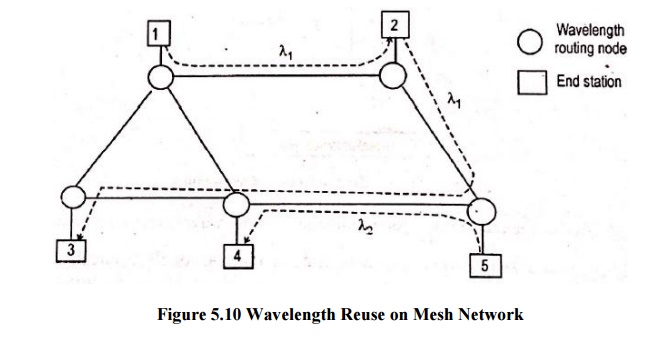Chapter: Optical Communication and Networking : Optical Networks
Wavelength Routed Networks
Wavelength Routed Networks
· Two problems arise in broadcast and select networks,
· More wavelengths are needs as the number of nodes in the network grows.
· Without the widespread are use of optical booster amplifier, due to this splitting losses is high.
· Wavelength routed networks overcome these limitations through wavelength reuse, wavelength conversion, and optical switching.
· The physical topology of a wavelength routed network consists of optical wavelength routers interconnected by pair of point-to-point fiber link in an arbitrary mesh configuration.

· Each link can carry a certain number off wavelength which can be directed independently to differently output paths at a node.
· Each node may have logical connections with several other nodes in the network, where each connection uses a particular wavelength.
· The paths taken by any two connections do not overlap, they can use the same wavelength.
1. Optical Cross Connect
· The concept of an optical cross connect architecture is the physical path structure, have a high degree of path modularity, capacity scaling, and flexibility in adding or dropping channels at a user site can be achieved.
· The physical path structure is called as path layer.
· These cross connects (OXCs) operate in the optical domain and can route very high capacity WDM data streams over a network of interconnected optical paths.

· OXC architecture uses space switching without wavelength conversion.
· The space switching can be constructed of a cascade of electronically controlled optical directional-coupler elements or semiconductor-optical-ampliier switching gates.
· Each of the input fiber carries a M wavelengths.
· The input, arriving aggregate if signal wavelength is amplified and divided into N streams by a power splitter.
· Tunable filter then select individual wavelengths, which are directed to an optical space switching matrix.
· A waveguide grating demultiplexer could be used to divide the incoming aggregate stream into individual wavelength channels.
· The switch matrix directs the channels either output lines, or to a particular receiver attached to the OXC at outputs ports 9 through 12.
· Signals that are generated locally by a user get connected electrically via the digital cross connect matrix (DXC) to an optical transmitter.
· They enter the switch matrix, which directs them to the appropriate output line.
· The M output lines, each carrying separate wavelength, are fed into a wavelength multiplexer (‘mux’ and a demultiplexer is ‘demux’) to form a single aggregate output stream.
· An optical amplifier to boost the signal level for transmission over the trunk fiber.
2. Performance Evaluation of Wavelemgth Conversion
· These effects are
(1) Probability models
(2) Deterministic algorithms
· The benefits are greater in a mesh network than in a ring or fully connected network.
The Effect of Wavelength Conversion
· Simple model, circuit switched networks is used.
· The probability that a wavelength is blocked along a path.
· It provides insight into the network performance improvement using wavelength conversion.
· Assume H links (or hops) between two nodes A and B.
· The expected number of busy wavelength on any link is ρF, where ρ is a measure of the fiber utilization along the path and F is the number of a available wavelengths per fiber link.
Related Topics